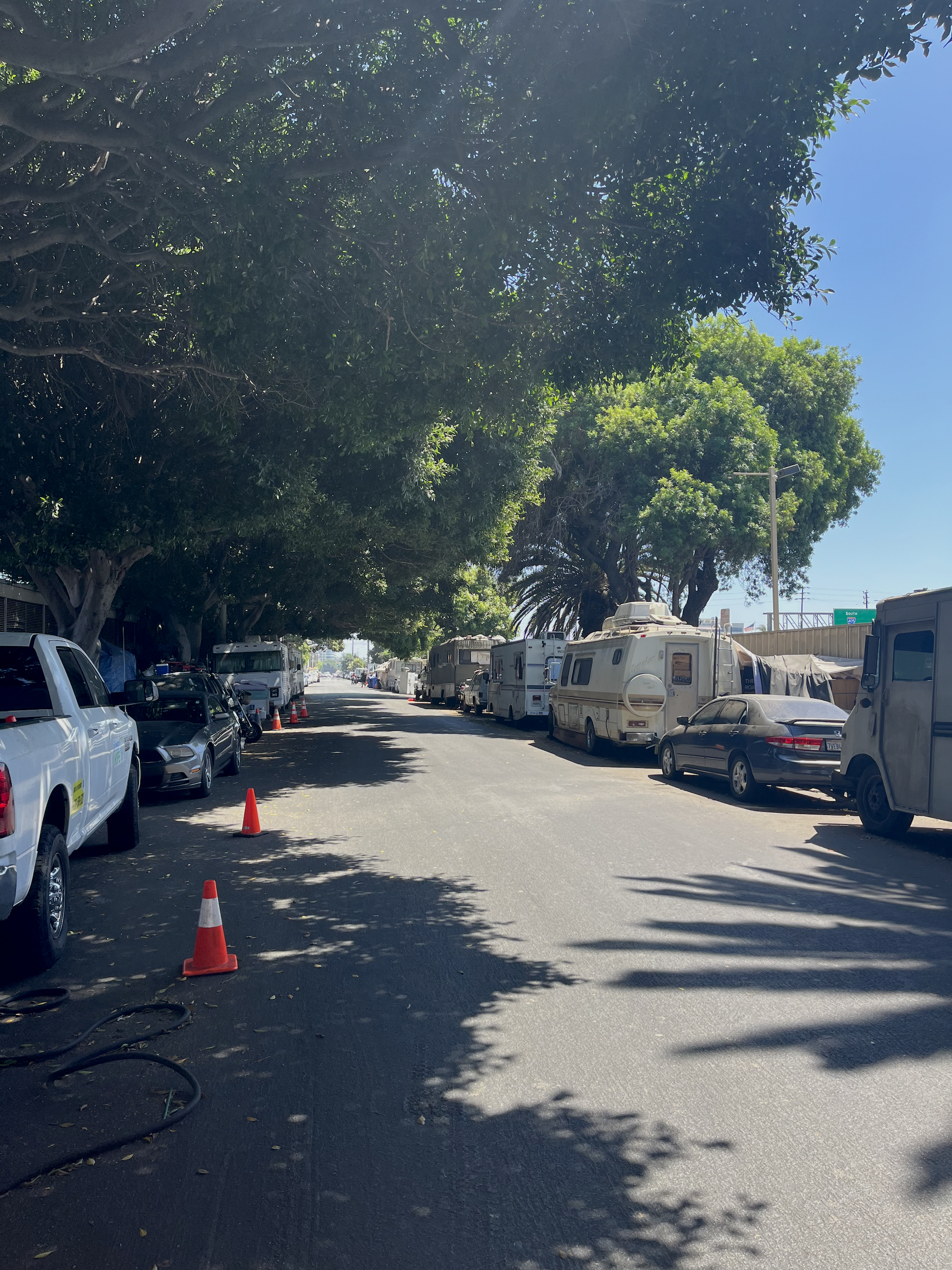LOS ANGELES — After LA County officials issued a controversial call for public art to decorate recreational vehicle (RV) encampment sites from which unhoused people have been displaced, over 150 artists and housing advocates have signed an open letter denouncing the project, which they say seeks to “‘beautify’ (i.e. cover up) sites of trauma and loss.”
“These are not just RVs — they are actually people’s homes and even more importantly, together they are communities,” reads the letter, sent on October 1 and distributed by artists Hayk Makhmuryan and Carol Zou and activist Judy Branfman.
“Lives depend on these networks and nearby services. Targeting poor people in this way seems like political maneuvering,” the missive continues. “Why not use highly creative approaches to help people get back on their feet?”
Issued by the Los Angeles County Department of Arts and Culture (LACDAC), County Supervisors, and Los Angeles Housing Services Authority (LAHSA), the call invited artists to provide public art for encampment areas including “any barriers erected to discourage RVs from returning once they have been removed.”
The recent letter outlined concerns with the initiative, including the recruitment of artists to create or embellish barriers to prevent RVs after the county evicts them, and the inefficacy of programs like LA Mayor Karen Bass’s initiative Inside Safe, which they say fails to provide comprehensive, long-term housing.
“Actively participating in the displacement of unhoused residents is antithetical to what artists do,” reads the artists’ recent letter. “Respect commonalities, meet people where they are, create trust, build relationships, co-create, and speak truth to power.”
In October 2023, LA County passed the so-called “RV resolution” meant to reduce the number of these vehicles parked across LA by forcing residents out into “interim housing” under a program known as Pathway Home. The program and the call for artists are part of LA County’s Homeless Initiative program, launched in February 2016.
On October 3, Branfman, Makhumuryan, and Zou met with LA County Deputy Supervisor Isela Gracian, whose office oversees much of downtown Los Angeles. The artists told Hyperallergic that they reiterated their concerns outlined in the letter and their demand to rescind and rewrite the call for proposals with a narrative that prioritizes artistic engagement with RV residents, and for LACDAC to host a public conversation as part of the process.
By the end of the meeting, Gracian allegedly confirmed that even if no artists applied, the county was determined to move ahead with the project, which she described as “experimental,” with or without the Department of Arts and Culture.
Branfman, one of the letter’s co-authors, told Hyperallergic that she was disappointed by the outcome.
“There are so many ways we could work together to find caring solutions rather than furthering divisions among marginalized communities and using artists to cover that up,” Branfman said.
On June 28, the United States Supreme Court ruled in City of Grants Pass v. Johnson that cities can enforce bans on public camping and sleeping without violating the Eighth Amendment, even if adequate shelter options are unavailable.
Within a month of this ruling and in the height of one of the hottest summers on record, California Governor Gavin Newsom ordered state agencies to sweep through encampments, which intensified locally in the City of Los Angeles by September, when many RV residents moved to unincorporated areas.
“As a sociologist who does research with vehicle residents in Los Angeles, I’m concerned to see LACDAC misuse the language of ‘community,” Sam Lutzker, a PhD candidate in the Department of Sociology at the University of California, Los Angeles, told Hyperallergic.
As an emergency response program launched in August 2023 in accordance with the RV resolution, Pathway Home targets the 120 unincorporated zones in LA county, where 538 RVs have been removed or pushed out of the area, despite having long-term residency in their communities and regardless of whether or not those residents living in RVs were housed short- or long-term. The program’s online dashboard says that 824 individuals were “moved into interim housing.”
“Where have all of those vehicle residents gone?” said Lutzker. “Pathway Home has not been transparent with its program data, especially regarding participant returns to homelessness.”
Hyperallergic has contacted Christina Villacorte, liaison for LA County’s Homeless Initiative program, as well as LA County Deputy Supervisors Gracian, Kathryn Barger, Janice Hahn, Lindsey Horvath, and Hilda Solis.
LACDAC did not respond to requests for comment.
According to a 2024 report, between 2021 and 2023, the city spent around $3 million on sweeps and enforcement, but only two people remained in long-term, permanent housing. Most cleared encampments were repopulated within weeks, suggesting that sweeps are an ineffective long-term solution to the region’s housing crisis.
“The city and county have numerous tools at their disposal,” Makhumuryan told Hyperallergic. Passing strict tenants’ rights protections and redirecting funds to build social housing projects with funded maintenance and built-in supports are two ideas Makhumuryan advocates for as an artist.
“Artists are community members who are impacted ourselves by rising rents and eviction,” Zou, an artist who often works with non-arts organizations, told Hyperallergic.
“We are asking the Board of Supervisors, LAHSA, and LACDAC, to open up their imaginations and imagine a world in which art can uplift, humanize, and resource the most marginalized in our society,” Zou said.

